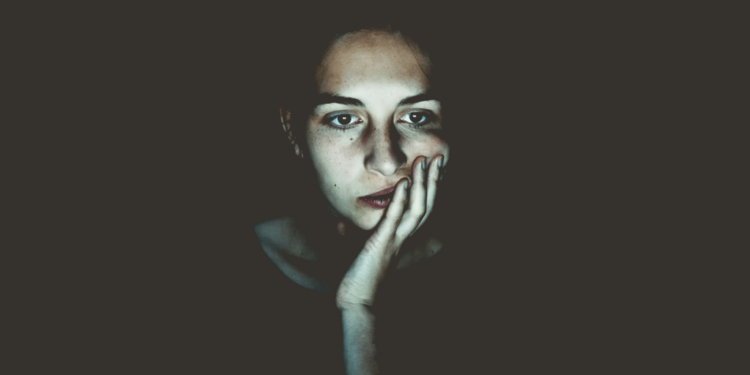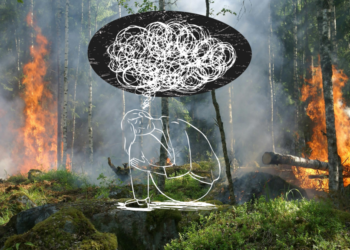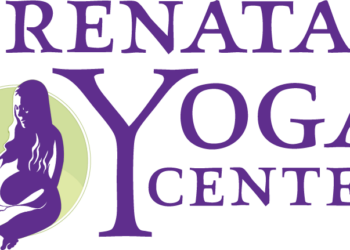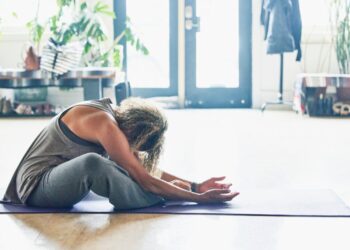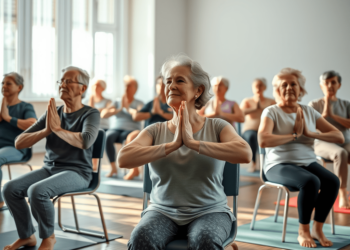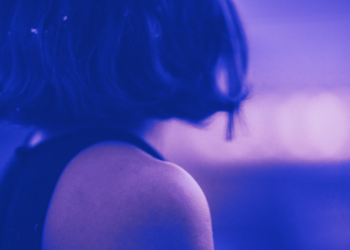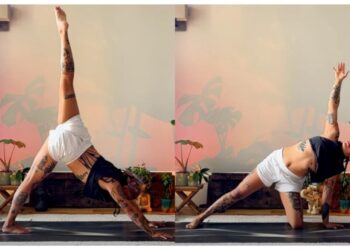“], “filter”: { “nextExceptions”: “img, blockquote, div”, “nextContainsExceptions”: “img, blockquote, a.btn, a.o-button”} }”>
Heading out the door? Learn this text on the brand new Outdoors+ app obtainable now on iOS units for members!
>”,”identify”:”in-content-cta”,”kind”:”hyperlink”}}”>Obtain the app.
There have been a number of occasions in my life when it felt as if the Earth’s gravitational pull had doubled in my private orbit. Instances when getting away from bed was a battle. Instances when remaining upright, particularly once I wanted to face in entrance of a room of scholars and educate yoga, felt prefer it took all of my power.
A few of these intervals of time had been associated to grief. Others had been linked to psychological well being challenges. Every time I discover myself emotionally burdened, I’ve discovered my yoga follow to be a supply of large lightness. Even on these days when it took every little thing inside me to be vertical, I discovered that after I began transferring my physique into sure supported shapes with consciousness, just a little of no matter depth I’d been carrying often launched—even once I didn’t perceive precisely what had triggered that heaviness.
Yoga for When You’re Emotionally Exhausted
I’ve discovered that once I follow yoga poses that supply an underlying power of assist and likewise an aspect of opening, I can often discover some aid and begin to come again to myself. The next poses are those that have a tendency to assist me probably the most.
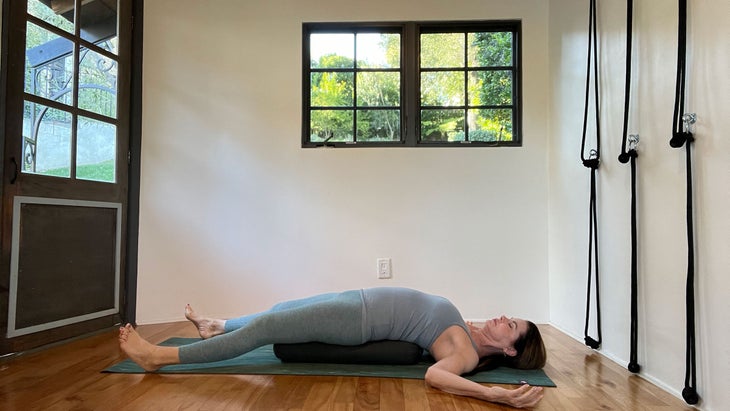
Setu Bandha Sarvangasana (Bridge Pose), Variation
How the pose helps: Poses that enable us to be absolutely supported by props incorporate gravity in an effort to let the physique and nervous system absolutely settle. Once we’re feeling emotionally distraught, any floor that we are able to collapse on—whether or not the ground, mattress, or sofa—can really feel nearly magnetized. It’s as if the physique intuitively is aware of that we have to lie down and get grounded—even once we’re additionally in a slight backbend, which may open our physique and our thoughts to extra power and new potential.
This variation on Bridge Pose releases the trapezius muscle tissue, that are the diamond-shaped muscle tissue of the higher again and shoulders. Once we’re below strain or overwhelmed, our traps are inclined to tighten like a turtle shell of accountability and stress, which makes issues really feel even weightier.
Find out how to: Place a bolster, a rolled-up yoga mat, stacked mattress pillows, or a few yoga blankets folded into slender rectangles lengthwise down the middle of your mat. Sit on the fringe of the bolster, mat, or blankets, dealing with the other way, and slowly decrease your self onto the assist. Alter your physique in order that your decrease and center again are draped on the assist and your shoulder blades and higher again are totally on the ground.
The important thing to this pose is sliding your higher again away from the assist as wanted. You may be tempted to shimmy, however sliding will enable no matter you’re mendacity on to drag your trapezius muscle tissue away out of your ears, which permits your neck to be mild and lengthy. If it’s comfy in your decrease again, straighten your legs. In any other case, hold your knees bent and your toes flat on the mat roughly hip-distance aside. Launch your arms by your sides, palms dealing with the ceiling. Keep right here for a minimum of 20 breaths.
To come back out, bend your knees and roll to at least one facet. Take your time coming again to sitting and slowly carry your head final.
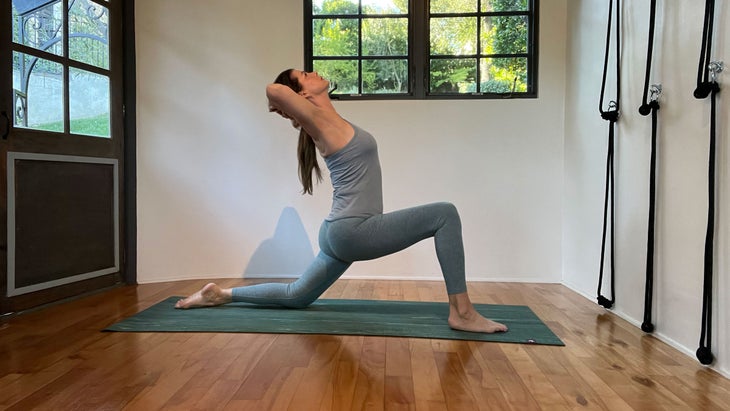
Anjaneyasana (Low Lunge), Variation
How the pose helps: Throughout difficult intervals, our our bodies can appear to fold in upon themselves—our shoulders get hunched, our chests collapse, and our heads grasp low. Curling inward is an adaptive response to guard our important organs. Whereas that is the form we’d wish to make if we had been about to be attacked within the wild, many people have a tendency to reply this solution to on a regular basis stressors, whether or not we cringe in response to an disagreeable e-mail or startle on the honk of a horn. This model of Low Lunge encourages you to open your entrance physique with just a little further assist out of your palms behind your head, which kinds a hammock and permits you to relaxation your head as you open your complete entrance physique.
Find out how to: From sitting, come to Adho Mukha Svanasana (Downward-Going through Canine Pose), inhale and carry your proper leg. As you exhale, step your proper foot towards the entrance of the mat. Decrease your again knee to the ground and, on an inhalation, carry your torso upright and attain your arms according to your ears. Deliver your palms collectively to the touch and bend your elbows. Level your fingers down, and hook your thumbs proper behind the bottom of your cranium, along with your elbows pointing upward. Inhale and carry your chest, then on an exhale, start to lean your head again into your palms. Gently draw your palms away from you to elongate the again of your cranium as you arch your again. Search for in case your neck permits or flip your gaze down towards your cheeks. Maintain for five breaths.
To come back out, on an inhalation, slowly carry your self upright, utilizing your palms to proceed to assist and carry your head. Attain your arms according to your ears for one breath earlier than decreasing them to the ground. Return to Down Canine and change sides.
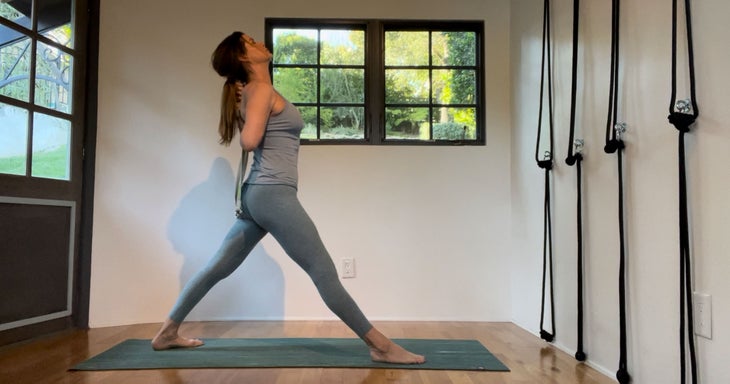
Parsvottanasana (Pyramid | Intense Facet Stretch Pose), Variation
How the pose helps: Gravity is just not the enemy. In truth, we are able to study to make use of it to really feel freedom and launch simply as a lot as we are able to use it as a type of resistance. Historically, Parsvottanasana is practiced as a ahead bend on the hips mixed with a slight backbend. The classical form will be highly effective for instructing us carry towards strain, however once we’re already below an infinite quantity of strain, this effort will be exhausting. As an alternative, including Gomukhasana (Cow Face) arms supplies assist for us to lean ahead, to go along with gravity, if you’ll. On this means, utilizing gravity doesn’t simply collapse us ahead, however helps us unfurl open because of a slight backbend.
Find out how to: From Down Canine, come to face on the prime of your mat, with a strap, a towel, or a long-sleeve shirt draped over your proper shoulder. Step your left foot again about 3 toes. Maintain your toes hip-width aside. Angle your left foot ahead sufficient that you just really feel secure. To take Gomukhasana (Cow Face) arms, inhale your proper arm as much as the sky and switch your palm to face away from you, bend your proper elbow, and maintain the strap, towel, or shirt in that hand. Attain your left arm out to the facet and switch your palm away from you towards the wall behind you, thumb down. Bend your left elbow, and both clasp fingers or grip your strap. Inhale to deliver a slight arch to your higher again, lifting your chest upward. On an exhale, begin to lean again. Let the strap or your palms act as a assist to your again. Keep for 8 breaths.
To come back out, on an inhalation, carry your self upright. Launch your strap and step your left foot as much as meet your proper. Repeat on the opposite facet.

Laghu Vajrasana (Little Thunderbolt Pose), Variation
How the pose helps: Now that we’re beginning to open, let’s tackle this cousin of Camel Pose that’s designed to elongate our entrance physique, from thighs to throat, in addition to encourage components of belief and give up—two qualities that may be arduous to entry once we’re gripping tightly for any purpose. Annie Carpenter, creator of SmartFLOW yoga, calls this dynamic variation “Pigeon Drops.”
Find out how to: Come to sit down in your knees and stack 2 blocks a couple of inches behind your bum. (In case you don’t have blocks, you possibly can situate a sofa or chair there, too.) Arise in your knees and calmly place your palms in your sacrum, fingers pointing down. On an inhalation, carry via your backbone. As you exhale, transfer your palms to the backs of your thighs and lean again at your knees. Curl your backbone so the crown of your head goals towards the blocks. Begin to lean again at your knees (hiya, quadriceps!) and attempt to contact your crown to the blocks. (You might not make all of it the way in which, and that’s completely effective. The blocks are merely there to encourage a deeper arch in your backbone. In case your higher again nonetheless feels restricted, pile your blocks even increased so your head has assist. If you’re pretty cell on this path, chances are you’ll solely want one block on excessive.)
When you contact your head to the block, inhale your self upright and sit in your knees to pause. Repeat a minimum of as soon as extra. In your third spherical, chances are you’ll wish to play with holding the form, sliding your palms additional down the backs of your legs or knees if wanted. Keep for five breaths. Use your inhalation to come back upright and sit in your heels for a couple of moments to pause.

Supine Vrksasana (Reclining Tree Pose)
How the pose helps: OK, now we come to the ground for a less-challenging variation of Tree Pose that may be a delicate hip opener in addition to a launch for the decrease again. After the emphasis on backbending and entrance physique opening within the earlier poses, chances are you’ll really feel fairly totally different than you probably did coming to the ground in the beginning of the sequence. It’s attainable that gravity and the assist of the ground will enable your chest to open even additional, whereas earlier mendacity on the ground could have made you wish to curl inward as a substitute.
Find out how to: Lie in your again. In case you’re pregnant, have low again ache, or are in any other case unable to lie utterly flat comfortably, you possibly can prop your backbone at a slight incline utilizing two blocks (one below your shoulder blades and one other below your head) or you possibly can place a bolster atop the blocks. Pull your proper heel towards your left internal thigh and permit your proper knee flop open. You might observe your pelvis falling towards your bent knee leg, simply enable it. Don’t fear about alignment proper now. Let your physique, the ground, and gravity decide the form of your physique. Take your arms huge right into a cactus form. Shut your eyes or soften your gaze. Stay right here for 10 breaths.
Straighten your leg and stretch earlier than organising in your different facet.

Supta Matsyendrasana (Supine Spinal Twist), Variation
How the pose helps: The great thing about this twist lies in its openness. Numerous twists depend on our physique components crossing over one another to deepen the rotation. For instance, Parivrtta Utkatasana (Revolved Chair) or Parivrtta Trikonasana (Revolved Triangle) by which the underside hand involves the mat exterior the entrance foot. These twists are known as closed twists. There may be additionally a subset of twists by which the stomach and chest stay unobstructed which are often known as open twists. This reclining pose is the latter sort of twist.
Additionally, there’s something psychologically neutralizing about twisting on the finish of follow. It’s a metaphoric wringing out of any lingering heaviness nonetheless inside you.
Find out how to: Stay in your again, pull each knees into your chest, and pause right here. Place your toes on the ground and take them a couple of inches wider than your hips. Maintain your knees pointing upright. Stretch your arms out to your sides in a “T.” Drop your knees to the best, like windshield wipers, and switch your head towards the left. Breathe right here for so long as it feels good. Inhale your knees again via heart after which decrease them to the opposite facet, turning your head reverse your knees.
If you really feel the stretch is full, deliver each knees again as much as your chest and squeeze them in for a second.
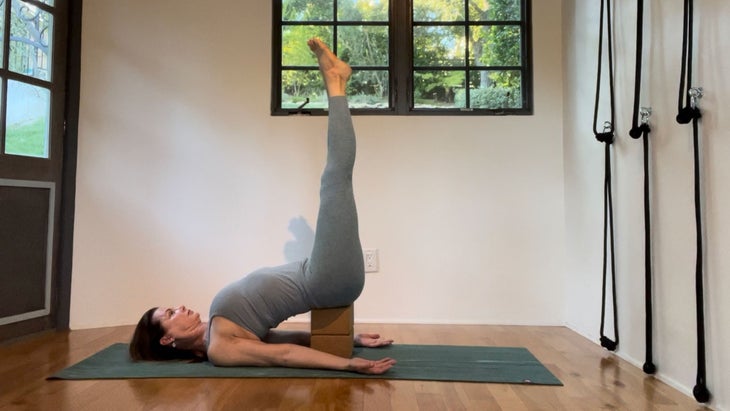
Supported Viparita Karani (Legs Up the Wall Pose)
How the pose helps: This model of Viparita Karani is usually known as “Waterfall.” A waterfall is an extremely highly effective picture of strain ultimately forming one thing calming and funky. Consider a robust stream pounding over the sting a cliff. In case you had been instantly beneath it, you’d doubtless be pushed below. However simply past the entry level, the waterfall creates a stunning pool. It’s as if the strain was essential to create the calm on the opposite facet. Supported Legs Up the Wall Pose, with our hips on a block or bolster, is a bodily expression of our skill to rework strain into softness.
Find out how to: Stay in your again and place your toes on the ground along with your knees bent. Seize your block (or bolster) and slide it beneath your sacrum. The peak of the block is as much as you. Some individuals like two blocks for extra of a backbend, some want one block on the bottom setting. If you situate the block so you’re feeling comfy, launch your arms down by your sides and seize the outer edges of your mat. Use your grip to magnify turning your higher arms externally (away out of your midline) open and tucking your shoulders beneath you. Subsequent, deliver your legs as much as the sky. You might begin along with your knees bent and even keep like that or you possibly can select to straighten your legs utterly. Stay right here for 3–5 minutes.
To come back out, bend your knees and place your toes on the ground. Pause right here in Supported Bridge Pose for a couple of moments earlier than lifting your hips up and eradicating the block. Decrease your again to the ground and slowly draw your knees into your chest. It might really feel good to rock proper and left for a second. Ultimately roll over to at least one facet and take your time as you employ the power of your arms to come back as much as sitting.
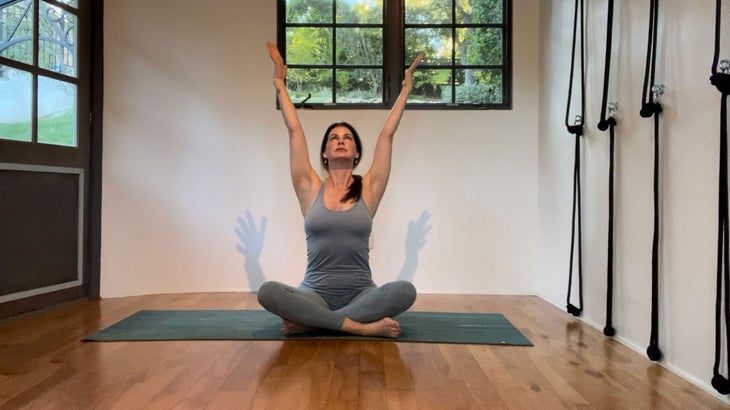
Shut your follow
Select no matter seated place is most comfy for you and both shut your eyes or soften your gaze towards the ground. Rub your palms collectively and, on an inhalation, attain your arms towards the sky in a “V” form, spreading your fingers huge. Observe the results of your follow. Know that lightness and launch are your baseline, your true state, and that you may at all times discover your means again to this.
This text has been up to date. Initially printed March 14, 2022.
“], “filter”: { “nextExceptions”: “img, blockquote, div”, “nextContainsExceptions”: “img, blockquote, a.btn, a.o-button”} }”>
Heading out the door? Learn this text on the brand new Outdoors+ app obtainable now on iOS units for members!
>”,”identify”:”in-content-cta”,”kind”:”hyperlink”}}”>Obtain the app.
There have been a number of occasions in my life when it felt as if the Earth’s gravitational pull had doubled in my private orbit. Instances when getting away from bed was a battle. Instances when remaining upright, particularly once I wanted to face in entrance of a room of scholars and educate yoga, felt prefer it took all of my power.
A few of these intervals of time had been associated to grief. Others had been linked to psychological well being challenges. Every time I discover myself emotionally burdened, I’ve discovered my yoga follow to be a supply of large lightness. Even on these days when it took every little thing inside me to be vertical, I discovered that after I began transferring my physique into sure supported shapes with consciousness, just a little of no matter depth I’d been carrying often launched—even once I didn’t perceive precisely what had triggered that heaviness.
Yoga for When You’re Emotionally Exhausted
I’ve discovered that once I follow yoga poses that supply an underlying power of assist and likewise an aspect of opening, I can often discover some aid and begin to come again to myself. The next poses are those that have a tendency to assist me probably the most.

Setu Bandha Sarvangasana (Bridge Pose), Variation
How the pose helps: Poses that enable us to be absolutely supported by props incorporate gravity in an effort to let the physique and nervous system absolutely settle. Once we’re feeling emotionally distraught, any floor that we are able to collapse on—whether or not the ground, mattress, or sofa—can really feel nearly magnetized. It’s as if the physique intuitively is aware of that we have to lie down and get grounded—even once we’re additionally in a slight backbend, which may open our physique and our thoughts to extra power and new potential.
This variation on Bridge Pose releases the trapezius muscle tissue, that are the diamond-shaped muscle tissue of the higher again and shoulders. Once we’re below strain or overwhelmed, our traps are inclined to tighten like a turtle shell of accountability and stress, which makes issues really feel even weightier.
Find out how to: Place a bolster, a rolled-up yoga mat, stacked mattress pillows, or a few yoga blankets folded into slender rectangles lengthwise down the middle of your mat. Sit on the fringe of the bolster, mat, or blankets, dealing with the other way, and slowly decrease your self onto the assist. Alter your physique in order that your decrease and center again are draped on the assist and your shoulder blades and higher again are totally on the ground.
The important thing to this pose is sliding your higher again away from the assist as wanted. You may be tempted to shimmy, however sliding will enable no matter you’re mendacity on to drag your trapezius muscle tissue away out of your ears, which permits your neck to be mild and lengthy. If it’s comfy in your decrease again, straighten your legs. In any other case, hold your knees bent and your toes flat on the mat roughly hip-distance aside. Launch your arms by your sides, palms dealing with the ceiling. Keep right here for a minimum of 20 breaths.
To come back out, bend your knees and roll to at least one facet. Take your time coming again to sitting and slowly carry your head final.

Anjaneyasana (Low Lunge), Variation
How the pose helps: Throughout difficult intervals, our our bodies can appear to fold in upon themselves—our shoulders get hunched, our chests collapse, and our heads grasp low. Curling inward is an adaptive response to guard our important organs. Whereas that is the form we’d wish to make if we had been about to be attacked within the wild, many people have a tendency to reply this solution to on a regular basis stressors, whether or not we cringe in response to an disagreeable e-mail or startle on the honk of a horn. This model of Low Lunge encourages you to open your entrance physique with just a little further assist out of your palms behind your head, which kinds a hammock and permits you to relaxation your head as you open your complete entrance physique.
Find out how to: From sitting, come to Adho Mukha Svanasana (Downward-Going through Canine Pose), inhale and carry your proper leg. As you exhale, step your proper foot towards the entrance of the mat. Decrease your again knee to the ground and, on an inhalation, carry your torso upright and attain your arms according to your ears. Deliver your palms collectively to the touch and bend your elbows. Level your fingers down, and hook your thumbs proper behind the bottom of your cranium, along with your elbows pointing upward. Inhale and carry your chest, then on an exhale, start to lean your head again into your palms. Gently draw your palms away from you to elongate the again of your cranium as you arch your again. Search for in case your neck permits or flip your gaze down towards your cheeks. Maintain for five breaths.
To come back out, on an inhalation, slowly carry your self upright, utilizing your palms to proceed to assist and carry your head. Attain your arms according to your ears for one breath earlier than decreasing them to the ground. Return to Down Canine and change sides.

Parsvottanasana (Pyramid | Intense Facet Stretch Pose), Variation
How the pose helps: Gravity is just not the enemy. In truth, we are able to study to make use of it to really feel freedom and launch simply as a lot as we are able to use it as a type of resistance. Historically, Parsvottanasana is practiced as a ahead bend on the hips mixed with a slight backbend. The classical form will be highly effective for instructing us carry towards strain, however once we’re already below an infinite quantity of strain, this effort will be exhausting. As an alternative, including Gomukhasana (Cow Face) arms supplies assist for us to lean ahead, to go along with gravity, if you’ll. On this means, utilizing gravity doesn’t simply collapse us ahead, however helps us unfurl open because of a slight backbend.
Find out how to: From Down Canine, come to face on the prime of your mat, with a strap, a towel, or a long-sleeve shirt draped over your proper shoulder. Step your left foot again about 3 toes. Maintain your toes hip-width aside. Angle your left foot ahead sufficient that you just really feel secure. To take Gomukhasana (Cow Face) arms, inhale your proper arm as much as the sky and switch your palm to face away from you, bend your proper elbow, and maintain the strap, towel, or shirt in that hand. Attain your left arm out to the facet and switch your palm away from you towards the wall behind you, thumb down. Bend your left elbow, and both clasp fingers or grip your strap. Inhale to deliver a slight arch to your higher again, lifting your chest upward. On an exhale, begin to lean again. Let the strap or your palms act as a assist to your again. Keep for 8 breaths.
To come back out, on an inhalation, carry your self upright. Launch your strap and step your left foot as much as meet your proper. Repeat on the opposite facet.

Laghu Vajrasana (Little Thunderbolt Pose), Variation
How the pose helps: Now that we’re beginning to open, let’s tackle this cousin of Camel Pose that’s designed to elongate our entrance physique, from thighs to throat, in addition to encourage components of belief and give up—two qualities that may be arduous to entry once we’re gripping tightly for any purpose. Annie Carpenter, creator of SmartFLOW yoga, calls this dynamic variation “Pigeon Drops.”
Find out how to: Come to sit down in your knees and stack 2 blocks a couple of inches behind your bum. (In case you don’t have blocks, you possibly can situate a sofa or chair there, too.) Arise in your knees and calmly place your palms in your sacrum, fingers pointing down. On an inhalation, carry via your backbone. As you exhale, transfer your palms to the backs of your thighs and lean again at your knees. Curl your backbone so the crown of your head goals towards the blocks. Begin to lean again at your knees (hiya, quadriceps!) and attempt to contact your crown to the blocks. (You might not make all of it the way in which, and that’s completely effective. The blocks are merely there to encourage a deeper arch in your backbone. In case your higher again nonetheless feels restricted, pile your blocks even increased so your head has assist. If you’re pretty cell on this path, chances are you’ll solely want one block on excessive.)
When you contact your head to the block, inhale your self upright and sit in your knees to pause. Repeat a minimum of as soon as extra. In your third spherical, chances are you’ll wish to play with holding the form, sliding your palms additional down the backs of your legs or knees if wanted. Keep for five breaths. Use your inhalation to come back upright and sit in your heels for a couple of moments to pause.

Supine Vrksasana (Reclining Tree Pose)
How the pose helps: OK, now we come to the ground for a less-challenging variation of Tree Pose that may be a delicate hip opener in addition to a launch for the decrease again. After the emphasis on backbending and entrance physique opening within the earlier poses, chances are you’ll really feel fairly totally different than you probably did coming to the ground in the beginning of the sequence. It’s attainable that gravity and the assist of the ground will enable your chest to open even additional, whereas earlier mendacity on the ground could have made you wish to curl inward as a substitute.
Find out how to: Lie in your again. In case you’re pregnant, have low again ache, or are in any other case unable to lie utterly flat comfortably, you possibly can prop your backbone at a slight incline utilizing two blocks (one below your shoulder blades and one other below your head) or you possibly can place a bolster atop the blocks. Pull your proper heel towards your left internal thigh and permit your proper knee flop open. You might observe your pelvis falling towards your bent knee leg, simply enable it. Don’t fear about alignment proper now. Let your physique, the ground, and gravity decide the form of your physique. Take your arms huge right into a cactus form. Shut your eyes or soften your gaze. Stay right here for 10 breaths.
Straighten your leg and stretch earlier than organising in your different facet.

Supta Matsyendrasana (Supine Spinal Twist), Variation
How the pose helps: The great thing about this twist lies in its openness. Numerous twists depend on our physique components crossing over one another to deepen the rotation. For instance, Parivrtta Utkatasana (Revolved Chair) or Parivrtta Trikonasana (Revolved Triangle) by which the underside hand involves the mat exterior the entrance foot. These twists are known as closed twists. There may be additionally a subset of twists by which the stomach and chest stay unobstructed which are often known as open twists. This reclining pose is the latter sort of twist.
Additionally, there’s something psychologically neutralizing about twisting on the finish of follow. It’s a metaphoric wringing out of any lingering heaviness nonetheless inside you.
Find out how to: Stay in your again, pull each knees into your chest, and pause right here. Place your toes on the ground and take them a couple of inches wider than your hips. Maintain your knees pointing upright. Stretch your arms out to your sides in a “T.” Drop your knees to the best, like windshield wipers, and switch your head towards the left. Breathe right here for so long as it feels good. Inhale your knees again via heart after which decrease them to the opposite facet, turning your head reverse your knees.
If you really feel the stretch is full, deliver each knees again as much as your chest and squeeze them in for a second.

Supported Viparita Karani (Legs Up the Wall Pose)
How the pose helps: This model of Viparita Karani is usually known as “Waterfall.” A waterfall is an extremely highly effective picture of strain ultimately forming one thing calming and funky. Consider a robust stream pounding over the sting a cliff. In case you had been instantly beneath it, you’d doubtless be pushed below. However simply past the entry level, the waterfall creates a stunning pool. It’s as if the strain was essential to create the calm on the opposite facet. Supported Legs Up the Wall Pose, with our hips on a block or bolster, is a bodily expression of our skill to rework strain into softness.
Find out how to: Stay in your again and place your toes on the ground along with your knees bent. Seize your block (or bolster) and slide it beneath your sacrum. The peak of the block is as much as you. Some individuals like two blocks for extra of a backbend, some want one block on the bottom setting. If you situate the block so you’re feeling comfy, launch your arms down by your sides and seize the outer edges of your mat. Use your grip to magnify turning your higher arms externally (away out of your midline) open and tucking your shoulders beneath you. Subsequent, deliver your legs as much as the sky. You might begin along with your knees bent and even keep like that or you possibly can select to straighten your legs utterly. Stay right here for 3–5 minutes.
To come back out, bend your knees and place your toes on the ground. Pause right here in Supported Bridge Pose for a couple of moments earlier than lifting your hips up and eradicating the block. Decrease your again to the ground and slowly draw your knees into your chest. It might really feel good to rock proper and left for a second. Ultimately roll over to at least one facet and take your time as you employ the power of your arms to come back as much as sitting.

Shut your follow
Select no matter seated place is most comfy for you and both shut your eyes or soften your gaze towards the ground. Rub your palms collectively and, on an inhalation, attain your arms towards the sky in a “V” form, spreading your fingers huge. Observe the results of your follow. Know that lightness and launch are your baseline, your true state, and that you may at all times discover your means again to this.
This text has been up to date. Initially printed March 14, 2022.
